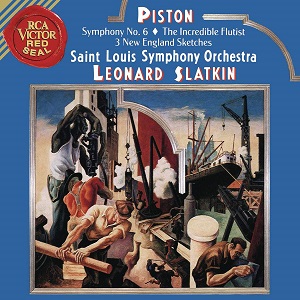
Walter Piston (1894-1976)
The Incredible Flutist (1938)
Three New England Sketches (1959)
Symphony No 6 (1955)
St Louis Symphony Orchestra/ Leonard Slatkin
rec. 1989-90
Presto CD
RCA 60798 [57]
During his years at the St Louis Symphony Orchestra (1979-1996) Leonard Slatkin trained them up to a high standard and made a number of recordings of American music for RCA, which seem to me to be among the best things he has done. They were also enhanced by delightful cover pictures based on paintings by Thomas Hart Benton from his America Today series. The series included three discs of Copland, two of Samuel Barber and single discs of several other composers, of whom Walter Piston, whom we have here, is one. It is good that they are now reappearing thanks to the Presto reissue programme.
Piston was one of a group of mid-twentieth century American composers who wrote symphonies. Bernstein and Copland are reasonably well known in the UK, but we hardly ever hear Roy Harris, William Schuman, David Diamond, Howard Hanson, Alan Hovhaness or, indeed, Walter Piston himself. He was a natural musician who, as a youth, played violin and piano in dance bands and then taught himself to play the saxophone and other wind instruments. He studied at Harvard and then went to Paris to study with Nadia Boulanger, making him a kind of grandpupil of Stravinsky. On returning to the USA, he taught at Harvard from 1926 until he retired in 1960. Perhaps his most noteworthy pupils were those two very different composers, Leonard Bernstein and Elliott Carter. He also wrote textbooks on harmony, counterpoint and orchestration which have remained standard works in their field.
As a composer he was prolific, producing eight symphonies, a dozen concertos or concertante works, a good deal of chamber music including five string quartets and numerous other works. His work is beautifully crafted, as one would expect of a former Boulanger pupil and a pedagogue, witty, inventive and memorable. However, recordings have been erratic: there is no integral set of the symphonies and I have managed to assemble recordings of only six of the eight. He deserves to be better known.
Here we have three works. We begin with the suite from Piston’s only ballet, The Incredible Flutist (in the UK we would say flautist). The story is set in a sleepy village at which a circus arrives. The Incredible Flutist is a member of this company and flirts with the local merchant’s pretty daughter. The merchant himself had been courting a rich widow, who faints but is revived by the flutist. The circus moves on. This story bears a considerable resemblance to Petrushka, which was Stravinsky’s most admired work at the time, and the music, in thirteen numbers, is like the jollier numbers in that work. There is an evocative opening, a varied collection of entrances and dances, a solo for the flutist and a polka finale. This is a delightful work, apparently Piston’s most popular piece, and well worth getting to know.
The Three New England Sketches came much later. The title is reminiscent of Ives’ Three Places in New England, and, although Piston disclaimed any particular geographical references in his work, you can hear something of Ives in his pieces. It is more chromatic than the Flutist, at times approaching expressionism. The opening sketch, Seaside, has a mysterious opening, but this moves to a huge climax. The second sketch, Summer Evening, is a fast, quiet scherzo. The final one, Mountains, begins Maestoso but has a faster section and also an atmospheric one. There is nothing sketchy about this composition, which is well worked out and rewarding.
Finally, we have Piston’s sixth symphony. Presumably Slatkin, having to choose one out of the eight, considers this the best, and perhaps it is, though I think the fourth is also in with a shout. There are four movements. The first is in sonata form, with a forceful opening and some pungent writing for the brass. A harp solo leads to a second subject featuring wind solos. After a development section, the recapitulation brings back the first subject only at the end. The second movement is a scherzo marked leggerissimo vivace. It begins with fast, quiet scurrying strings and the percussion is prominent. Eventually a long winding theme emerges. The slow movement is meditative and serene and features a solo cello. Something about this movement reminded me of Shostakovich. The finale is fast and energetic but perhaps slightly impersonal.
These performances are expressive, confident and persuasive. The recording is good and the booklet helpful. If you are going to represent Piston in your collection by just one disc, this will do nicely. However, if you are sufficiently intrigued to want to explore him further, look out for recordings by Gerard Schwarz, who has done sterling work for this group of composers.
Stephen Barber
Help us financially by purchasing from




















